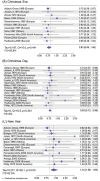Suicide risk on Christmas Eve, Christmas Day, New Year's Day, and Valentine's Day: a systematic review and meta-analysis
- PMID: 41098756
- PMCID: PMC12518309
- DOI: 10.3389/fpubh.2025.1668476
Suicide risk on Christmas Eve, Christmas Day, New Year's Day, and Valentine's Day: a systematic review and meta-analysis
Abstract
Objective: Holidays are times of celebration of family and loved ones which can be difficult for some people. This study assessed the risk of suicide on Christmas Eve, Christmas Day, New Year's Day, and Valentine's Day.
Methods: We searched four major electronic databases. The primary outcome was suicide deaths, and the secondary outcome was self-harm and suicide-related behaviors (SHSB). For each holiday, we calculated the risk ratio (RR) compared to regular days and the proportion of annual suicides.
Results: We included 28 studies (n = 2,186,094). The proportion of annual suicides was 0.23% [95% confidence interval, 0.17%, 0.28%; number of studies (k) = 11] on Christmas Eve, 0.24% (0.19%, 0.29%; k = 17) on Christmas Day, 0.39% (0.31%, 048%; k = 16) on New Year's Days, and 0.27% (0.24%, 0.30%; k = 5) on Valentine's Day. Compared to regular days, suicide risk was 17% lower (RR = 0.83; 0.72, 0.96) on Christmas Day and 33% higher on New Year's Day (RR = 1.33; 1.06, 1.65) with no significant difference for Christmas Eve or Valentine's Day. This pattern of lower suicide risk on Christmas and higher risk on New Year's Day was consistent across countries. Regarding SHSB, the proportions were 0.19% on Christmas Eve, 0.21% on Christmas Day, 0.29% on New Year's Day, and 0.23% on Valentine's Day, corresponding to a lower risk on Christmas Eve (RR = 0.74; 0.57, 0.96; k = 5) and a higher risk on New Year's Day (RR = 1.17; 1.03, 1.34; k = 6), but no significant difference on Christmas Day or Valentine's Day.
Conclusion: Our study suggests that only New Year's Day appears to be a temporal hotspot for suicide across most countries.
Systematic review registration: Open Science Framework (osf.io/7zx3d).
Keywords: Christmas; New Year's Day; Valentine's Day; self-harm and suicide related behavior; suicide.
Copyright © 2025 Yeh, Hsu, Kao, Thompson, Stubbs, Carvalho, Yang, Tseng, Hsu, Yu, Tu and Liang.
Conflict of interest statement
The authors declare that the research was conducted in the absence of any commercial or financial relationships that could be construed as a potential conflict of interest.
Figures





References
Publication types
MeSH terms
LinkOut - more resources
Full Text Sources
Medical

